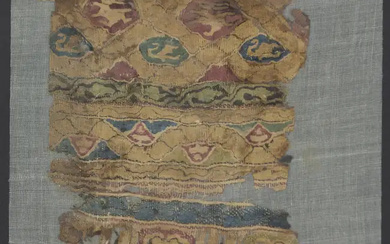TWO FATIMID INSCRIBED TEXTILE FRAGMENTS, EGYPT
Both with Kufic inscriptions embroidered in black silk on white linen ground reading: ‘Bismillah, Praise from Allah to Abdullah, Allah is the refuge for His messenger and believers and upon Him they trust’.
CATALOGUE NOTE:
The word tiraz is derived from the Persian word for embroidery and can refer to the textiles themselves, to the bands of inscription that were embroidered onto them, or to the factories in which they were produced. Tiraz vary widely in materials and appearance depending on when, where, and for whom they were produced. Most were made of linen, wool, cotton, or a fabric called mulham that was composed of a silk warp and cotton or other weft. Throughout the Islamic world, tiraz inscriptions were written in Kufic or floriated Kufic script, and later, in naskh or thuluth. They often include the bismillah, the name of the caliph, and the date and place of manufacture. Under the Fatimid Caliph al-Mu‘izz (r. 953-75), the khil‘a ceremony gained importance and the technical quality of tiraz garments came to reflect the wealth and influence of their recipients. In this ceremony, which can be traced to the time of the prophet Muhammad, the Caliph would bestow robes of honor upon deserving subjects. The epigraphic bands on many of these textiles documented new allegiances, confirmed loyalty to the Caliph and to Allah, and marked the recipient with honor. In Fatimid Egypt, silk robes woven with gold tiraz bands were reserved for the vizier and other high-ranking officials, while the general public wore linen.
Fragments of many linen tiraz have been found in Egyptian tombs, where they were used as shrouds and preserved due to the arid climate. Blessings (baraka) attained through the khil‘a ceremony and subsequent use during prayer imbued these textiles with special qualities that made them especially suited for this funerary purpose. Tiraz textiles were often wrapped around the head of the deceased with the text covering the eyes, which attests to the religious significance of these inscriptions.
View it on
Sale price
Estimate
Time, Location
Auction House
Both with Kufic inscriptions embroidered in black silk on white linen ground reading: ‘Bismillah, Praise from Allah to Abdullah, Allah is the refuge for His messenger and believers and upon Him they trust’.
CATALOGUE NOTE:
The word tiraz is derived from the Persian word for embroidery and can refer to the textiles themselves, to the bands of inscription that were embroidered onto them, or to the factories in which they were produced. Tiraz vary widely in materials and appearance depending on when, where, and for whom they were produced. Most were made of linen, wool, cotton, or a fabric called mulham that was composed of a silk warp and cotton or other weft. Throughout the Islamic world, tiraz inscriptions were written in Kufic or floriated Kufic script, and later, in naskh or thuluth. They often include the bismillah, the name of the caliph, and the date and place of manufacture. Under the Fatimid Caliph al-Mu‘izz (r. 953-75), the khil‘a ceremony gained importance and the technical quality of tiraz garments came to reflect the wealth and influence of their recipients. In this ceremony, which can be traced to the time of the prophet Muhammad, the Caliph would bestow robes of honor upon deserving subjects. The epigraphic bands on many of these textiles documented new allegiances, confirmed loyalty to the Caliph and to Allah, and marked the recipient with honor. In Fatimid Egypt, silk robes woven with gold tiraz bands were reserved for the vizier and other high-ranking officials, while the general public wore linen.
Fragments of many linen tiraz have been found in Egyptian tombs, where they were used as shrouds and preserved due to the arid climate. Blessings (baraka) attained through the khil‘a ceremony and subsequent use during prayer imbued these textiles with special qualities that made them especially suited for this funerary purpose. Tiraz textiles were often wrapped around the head of the deceased with the text covering the eyes, which attests to the religious significance of these inscriptions.




